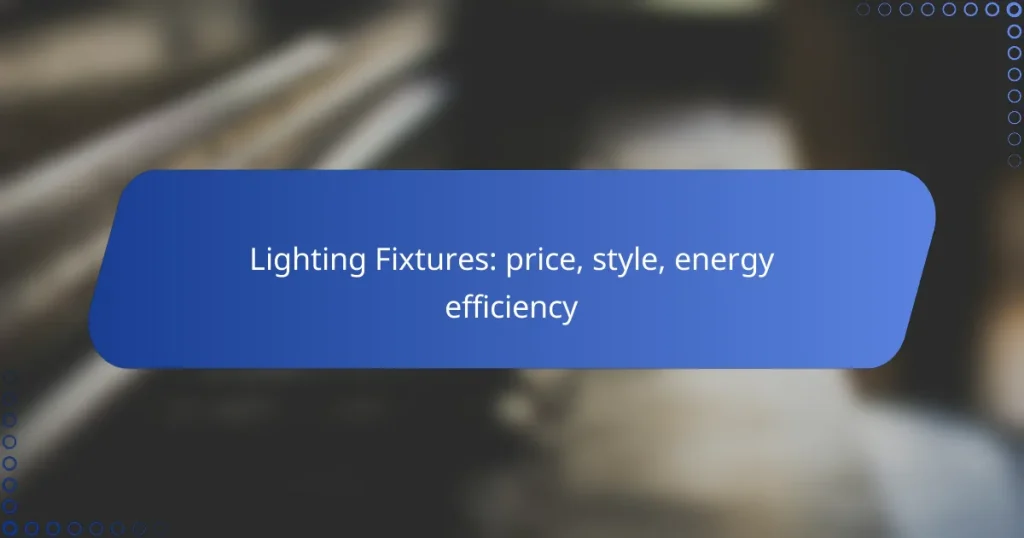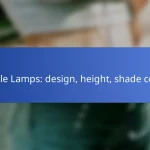When selecting lighting fixtures, it’s essential to consider factors such as price, style, and energy efficiency. In the UK, options range from budget-friendly basic fixtures to high-end designer pieces, catering to various tastes and needs. Popular styles include modern, industrial, and traditional designs, allowing homeowners to enhance their interiors while also benefiting from energy-efficient technologies like LED and smart lighting systems.
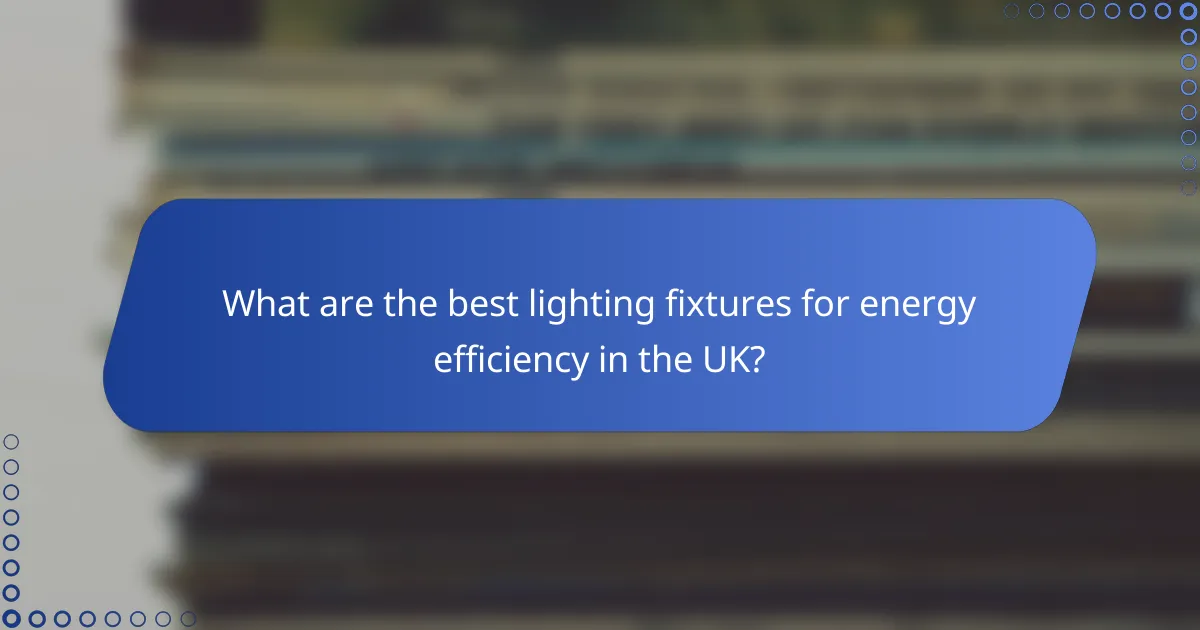
What are the best lighting fixtures for energy efficiency in the UK?
The best lighting fixtures for energy efficiency in the UK include LED lighting, CFL fixtures, and smart lighting systems. These options not only reduce energy consumption but also lower electricity bills and have a longer lifespan compared to traditional bulbs.
LED lighting fixtures
LED lighting fixtures are among the most energy-efficient options available, consuming up to 80% less energy than incandescent bulbs. They have a lifespan of around 15,000 to 50,000 hours, making them a cost-effective choice over time.
When selecting LED fixtures, consider the lumens output to ensure adequate brightness and check for the Energy Saving Trust certification to confirm energy efficiency. They are available in various styles, from recessed lights to decorative fixtures, suitable for any room.
CFL lighting fixtures
CFL (Compact Fluorescent Lamp) lighting fixtures are another energy-efficient choice, using about 70% less energy than traditional incandescent bulbs. They typically last around 10,000 hours, providing a good balance between cost and longevity.
While CFLs are generally less expensive than LEDs, they may take a moment to reach full brightness. Look for models that are labeled as “instant-on” for quicker illumination. Ensure proper disposal, as they contain a small amount of mercury.
Smart lighting systems
Smart lighting systems enhance energy efficiency by allowing users to control their lights remotely and set schedules. These systems can reduce energy use by automatically turning off lights when not needed or adjusting brightness based on natural light levels.
Investing in smart lighting can lead to savings on electricity bills, especially when combined with LED or CFL fixtures. Consider systems compatible with home automation platforms for seamless integration and enhanced convenience.

How much do lighting fixtures cost in the UK?
The cost of lighting fixtures in the UK varies widely based on style, type, and energy efficiency. Generally, you can expect to spend anywhere from £10 for basic fixtures to several hundred pounds for designer or high-tech options.
Average price range for LED fixtures
LED fixtures are popular for their energy efficiency and longevity. The average price for LED lights typically ranges from £20 to £150, depending on the design and features.
For example, simple LED bulbs can be found for as low as £10, while more elaborate LED ceiling lights or recessed fixtures may cost upwards of £100.
Average price range for pendant lights
Pendant lights offer a stylish option for various spaces, with prices generally ranging from £30 to £300. Basic models can be found for around £30, while designer or multi-light pendants can reach £200 or more.
When selecting pendant lights, consider the material and design, as these factors significantly influence the price. For instance, glass or metal fixtures tend to be on the higher end of the price spectrum.
Cost of smart lighting solutions
Smart lighting solutions, which allow for remote control and automation, typically range from £50 to £300. Basic smart bulbs can start at around £20, while comprehensive smart lighting systems may cost significantly more.
Keep in mind that while the initial investment is higher, smart lighting can lead to energy savings in the long run. Look for systems compatible with existing smart home setups to maximize functionality.
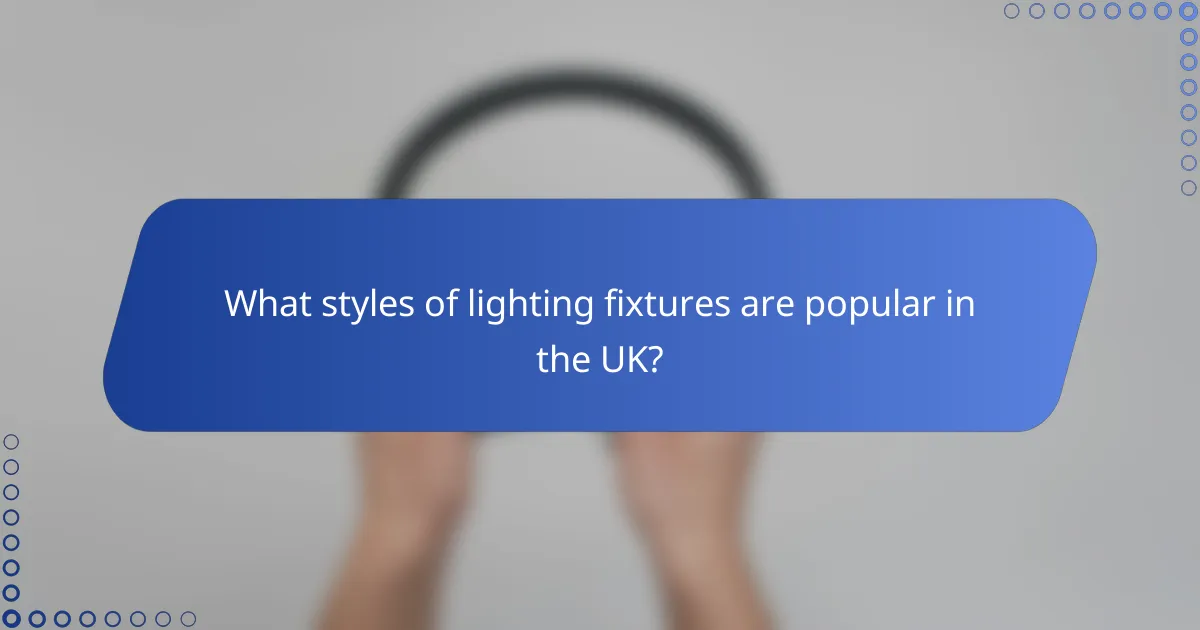
What styles of lighting fixtures are popular in the UK?
In the UK, popular lighting fixture styles include modern, industrial, and traditional designs, each offering unique aesthetics and functionality. Homeowners often choose fixtures based on their interior decor, energy efficiency, and personal preferences.
Modern lighting styles
Modern lighting styles emphasize clean lines and minimalistic designs, often incorporating materials like metal and glass. Fixtures such as pendant lights, wall sconces, and recessed lighting are common choices, providing a sleek look that complements contemporary interiors.
When selecting modern lighting, consider energy-efficient options like LED bulbs, which can significantly reduce electricity costs. These fixtures are available in various shapes and sizes, allowing for customization in any space.
Industrial lighting designs
Industrial lighting designs draw inspiration from factories and warehouses, featuring raw materials like exposed bulbs, metal finishes, and rustic elements. Popular fixtures include Edison bulbs, pendant lights with metal shades, and large floor lamps that create a bold statement.
These designs often work well in loft-style apartments or homes with an open layout. To enhance the industrial look, pairing these fixtures with vintage or reclaimed furniture can create a cohesive aesthetic.
Traditional lighting options
Traditional lighting options reflect classic styles, often featuring ornate details and warm finishes. Chandeliers, table lamps, and wall sconces are typical examples, frequently made from materials like brass or crystal to add elegance to a room.
When choosing traditional lighting, consider the size of the space and the height of the ceiling, as larger fixtures can overwhelm smaller rooms. Incorporating dimmer switches can also enhance the ambiance, allowing for adjustable lighting levels to suit different occasions.
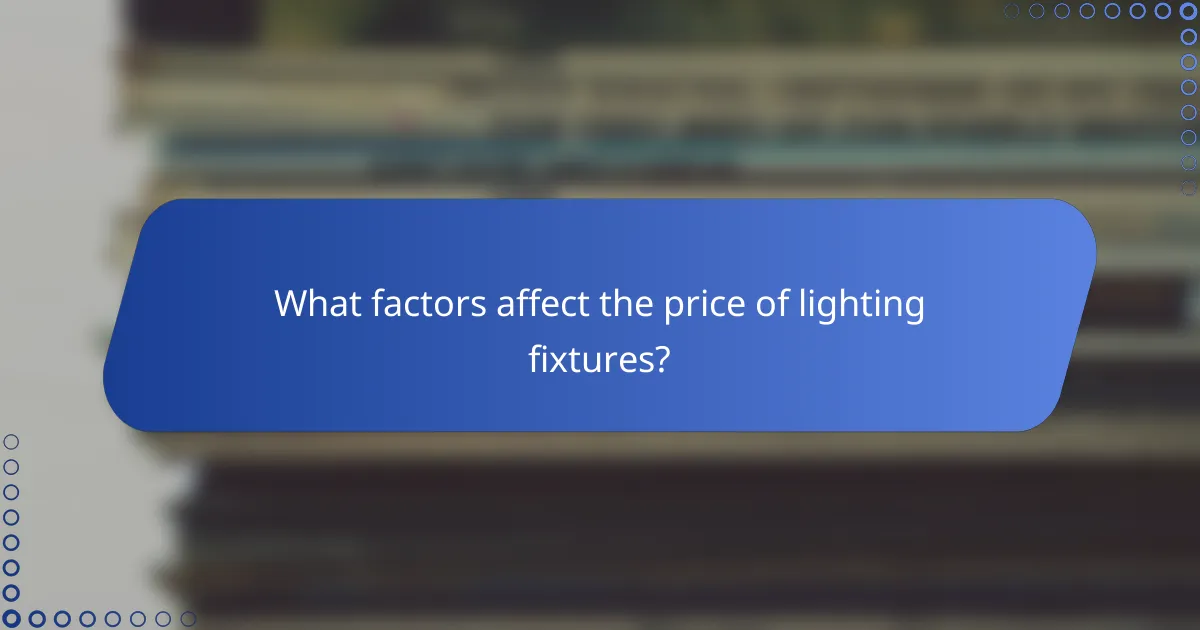
What factors affect the price of lighting fixtures?
The price of lighting fixtures is influenced by several key factors, including material quality, brand reputation, and design complexity. Understanding these elements can help consumers make informed purchasing decisions and find fixtures that fit their budget and style preferences.
Material quality
Material quality plays a significant role in determining the price of lighting fixtures. Higher-quality materials, such as solid metals or premium glass, tend to be more durable and visually appealing, which can justify a higher price point. In contrast, fixtures made from cheaper plastics or low-grade metals may be more affordable but often lack longevity and aesthetic value.
When shopping, consider the type of material used in the fixture. For example, fixtures made from brass or stainless steel typically range from $50 to $200, while those made from plastic can be found for as low as $20. Investing in quality materials can lead to long-term savings by reducing the need for replacements.
Brand reputation
Brand reputation significantly impacts the pricing of lighting fixtures. Established brands often charge a premium due to their reputation for quality, customer service, and design innovation. Consumers may be willing to pay more for a fixture from a trusted brand, knowing they are likely to receive a reliable product.
On the other hand, lesser-known brands may offer similar styles at lower prices, but the quality and customer support may vary. It’s essential to research brands and read reviews to gauge their reliability and the experiences of other customers before making a purchase.
Design complexity
Design complexity is another crucial factor affecting the price of lighting fixtures. Intricate designs, custom features, or unique artistic elements often require more time and craftsmanship, leading to higher costs. Simple, minimalist designs are generally more affordable due to lower production costs.
For example, a basic pendant light may cost around $30, while a handcrafted chandelier with elaborate detailing can range from $300 to over $1,000. When selecting a fixture, consider how the design aligns with your space and whether the investment in complexity is worth it for your aesthetic goals.
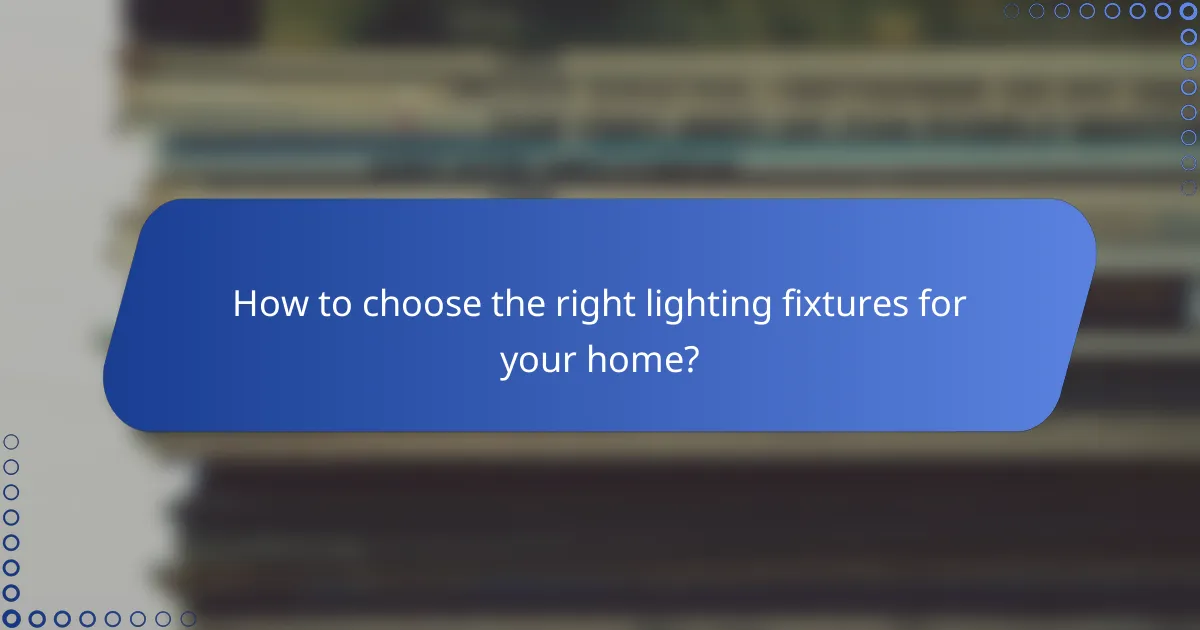
How to choose the right lighting fixtures for your home?
Selecting the right lighting fixtures involves considering the room’s size, your decor style, and energy efficiency. These factors will help you create a well-lit, aesthetically pleasing, and cost-effective environment in your home.
Assessing room size and layout
The size and layout of a room significantly influence the type of lighting fixtures you should choose. For larger spaces, consider using multiple fixtures or larger statement pieces to ensure adequate illumination. In contrast, smaller rooms may benefit from compact fixtures that maximize light without overwhelming the space.
Measure the dimensions of your room and consider the height of the ceiling. A general rule is to hang pendant lights about 30-36 inches above a dining table or kitchen island. For floor lamps, ensure they are tall enough to provide light without obstructing pathways.
Matching style with decor
Your lighting fixtures should complement your home’s overall decor style. Whether your home features modern, traditional, or eclectic design, choose fixtures that enhance the aesthetic. For instance, sleek metallic fixtures work well in contemporary settings, while ornate chandeliers suit more classic interiors.
Consider the color scheme and materials used in your decor. A cohesive look can be achieved by selecting fixtures that share similar finishes or colors with other elements in the room, such as furniture or wall paint.
Considering energy efficiency ratings
Energy efficiency is crucial when selecting lighting fixtures, as it impacts both your utility bills and environmental footprint. Look for fixtures that use LED bulbs, which typically consume less energy and have a longer lifespan compared to traditional incandescent bulbs.
Check for energy efficiency ratings such as ENERGY STAR certification, which indicates that the fixture meets strict efficiency guidelines. Additionally, consider dimmable options that allow you to adjust brightness and save energy when full illumination is unnecessary.

What are the benefits of smart lighting fixtures?
Smart lighting fixtures offer enhanced control, energy efficiency, and convenience, making them a popular choice for modern homes. They allow users to adjust brightness, color, and schedules from their smartphones or smart home systems, improving both functionality and ambiance.
Energy savings
Smart lighting fixtures can significantly reduce energy consumption compared to traditional lighting options. By utilizing LED technology and features like motion sensors and timers, these fixtures can lower electricity bills by up to 30-50% over time.
To maximize energy savings, consider using smart bulbs that automatically adjust brightness based on the time of day or occupancy. This ensures lights are only on when needed, further enhancing efficiency.
Remote control features
One of the standout benefits of smart lighting fixtures is their remote control capabilities. Users can operate lights from anywhere using a smartphone app or voice commands through smart assistants, providing unparalleled convenience.
These features allow for easy scheduling, dimming, and color changes, enhancing the user experience. However, ensure your Wi-Fi network is robust enough to support these devices for seamless operation.
